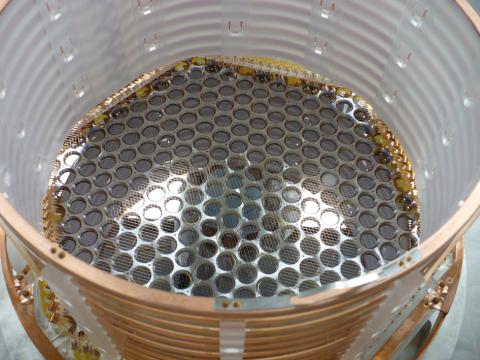
A well-known feature of the Standard Model of the elementary particles is that all fermions (e.g. electrons and quarks) are “Dirac” particles, meaning they have a corresponding antiparticle twin with identical mass but opposite quantum properties, like charge. However, there exists a hypothesis that instead of having distinct antiparticles, so-called “Majorana” particles may be their own antimatter twin. Determining whether neutrinos are Dirac- or Majorana-like is a key goal of modern particle physics, since being Majorana-like could possibly help explain why neutrinos have such a shockingly low mass. EXO-200 has recently announced a result that is helping scientists answer this fundamental question.
At EXO-200 (Enriched Xenon Observatory), physicists have been searching for a hypothesized radioactive decay that can occur only if the neutrino is a Majorana particle. Normal beta decay always involves emission of one neutrino per emitted beta particle. However, the so-called neutrinoless double beta decay, or 0νββ, does not; instead, the two neutrinos would annihilate one another, leaving only the two electrons in the final state. Detection of 0νββ decay would unambiguously indicate that neutrinos are Majorana-like.
On June 4th, 2014, a paper published in Nature revealed the results collected over the last two years by EXO-200. This unique detector consists of a chamber loaded with 110 kilograms of liquid xenon-136, a likely candidate for 0νββ decay.
Using an ultra-sophisticated detector, EXO-200 is able to determine with exquisite precision the energy of the two outgoing β-particles in double beta decay events. If the energy of the two β-particles is exactly equal to the energy difference between the Xenon-136 parent and the Ba-136 “daughter” nucleus, that would indicate that there were no neutrinos to carry of any energy, demonstrating 0νββ decay and proving that neutrinos are Majorana particles.
To date 0νββ decay has not been observed unambiguously, but EXO-200 placed the most stringent limits yet on the probability of its occurrence, while placing a limit on the neutrino mass of 0.2-0.4 electronvolts and greatly refining the half-life of Xe-136.
TRIUMF senior scientist and Carleton University professor David Sinclair has been involved with EXO-200 since its development. Sinclair was the 2011 winner of the CAP-TRIUMF Vogt Medal for his role in the design, development, and construction of the Sudbury Neutrino Observatory (SNO) that has helped establish that neutrinos have mass. His contributions provide a fruitful complement to TRIUMF’s other efforts in neutrino physics such as at T2K in Japan.
Sinclair commented on the complementary nature of EXO-200, saying, “EXO builds on both the science of the pioneering SNO project and on the technology developed by SNO for ultra-low background experiments. It complements the T2K search because each experiment is looking for different properties of the neutrino and all of the properties are needed to unravel the mysteries of this elusive particle.”
-Nick Leach, Outreach Assistant
Photo: The liquid-xenon 'time-projection chamber' used by the EXO-200 Collaboration in their investigation of neutrino properties.
